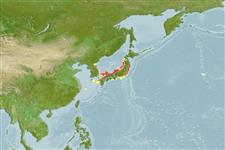>
Perciformes/Zoarcoidei (Eelpouts and pricklebacks) >
Lumpenidae (Eel pricklebacks)
Etymology: Xenolumpenus: Name from Greek, Xeno (= strange), and Latinized Danish, lumpenus (type genus of the subfamily Lumpeninae), for the elongated pectoral, pelvic and anal fin rays.; longipterus: Name from Latin, longus for long and Latinized Greek pteron for wing; referring to the elongate pectoral fins..
Environment: milieu / climate zone / depth range / distribution range
Ecologia
marinhas bentopelágico; intervalo de profundidade 167 - 300 m (Ref. 84251). Temperate
Northwest Pacific: Japan.
Tamanho / Peso / Idade
Maturity: Lm ? range ? - ? cm
Max length : 11.5 cm SL (female)
Descrição breve
Morfologia | Morfometria
Espinhos dorsais (total): 46 - 48; Espinhos anais 2; Raios anais moles: 30; Vértebras: 52 - 54. This species is distinguished by having the following characters: DXLVI-XLVIII; A II,28-30; membrane extremely incised, rays elongate; 11 pectoral-fin rays, including 3 ventralmost rays free from others and the longest ray 36.5-40.2% SL; pelvic fin rays elongate, membrane well-incised, and rays unbranched; 2 mandibular pores; 1 or 2 large black blotches on pectoral fin; black ocellus on caudal fin (Ref. 84251).
The specimens have well-developed ovaries containing ca. 1.5 mm diameter eggs, suggesting the spawning of the species occurs in autumn (Ref. 84251).
Life cycle and mating behavior
Maturidade | Reprodução | Desova | Ovos | Fecundidade | Larvas
Shinohara, G. and M. Yabe, 2009. A new genus and species of prickleback (Perciformes: Stichaeidae) from Japan. Ichthyol Res (2009)56:394-399. (Ref. 84251)
Categoria na Lista Vermelha da IUCN (Ref. 130435)
Ameaça para o homem
Harmless
Utilização humana
Mais informação
Nomes comunsSinónimosMetabolismoPredadoresEcotoxicologiaReproduçãoMaturidadeDesovaAgregação para desovaFecundidadeOvosDesenvolvimento dos ovos
Idade/TamanhoCrescimentoComprimento-pesoComprimento-comprimentoFrequência de comprimentoMorfometriaMorfologiaLarvasDinâmica larvarRecrutamentoAbundânciaBRUVS
ReferênciasAquaculturaPerfil para aquaculturaEstirpesGenéticaElectrophoresesHereditariedadeDoençasProcessamentoNutrientsMass conversion
ColaboradoresFotografiasStamps, Coins Misc.SonsCiguateraVelocidadeTipo de nataçãoÁrea branquialOutras referênciasCérebrosVisão
Ferramentas
Relatórios especiais
Descarregue XML
Fontes da internet
Estimates based on models
Preferred temperature (Ref.
123201): 2.2 - 17.7, mean 12.3 °C (based on 12 cells).
Phylogenetic diversity index (Ref.
82804): PD
50 = 1.0000 [Uniqueness, from 0.5 = low to 2.0 = high].
Bayesian length-weight: a=0.00129 (0.00052 - 0.00322), b=2.98 (2.76 - 3.20), in cm total length, based on LWR estimates for this (Sub)family-body shape (Ref.
93245).
Nível Trófico (Ref.
69278): 3.2 ±0.4 se; based on size and trophs of closest relatives
Resiliência (Ref.
120179): Elevada, tempo mínimo de duplicação da população menor que 15 meses (Preliminary K or Fecundity.).
Fishing Vulnerability (Ref.
59153): Low vulnerability (10 of 100).
